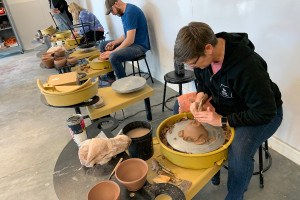My Morning Moka Pot Is the Calm Before the Storm
I never thought I’d have such a fraught relationship with coffee.

A morning moka pot brew is this writer’s calming ritual. | Courtesy of Getty Images
Welcome to Ritual, Be Well Philly’s column of essays about the low-tech, inefficient things we do that pleasurably slow us down. From taking the long way home to hand-washing dishes, these simple habits allow us to be more present — even if only for a few minutes.
Twitter, now, is the bridge I cross every morning to go to work. It’s part of my daily commute in the WFH era. I’ll start half-awake, scrolling through the Bad News of the Day, always just a few minutes before my alarm is scheduled to go off, always just a few minutes after some weird stress dream ends. I’m not sure why I do it to myself every single day — it’s a horrible way to regain consciousness — but it’s part of The Routine, and The Routine is what keeps me moving in the WFH era. If nothing kept me moving, I simply wouldn’t move.
So I begin my day on Twitter, flicking past news of murdering hornets, murdering racists, impending class wars, death, illness, death, illness, death, illness, snow storms in May, until finally, I’m fully awake, both eyes wide open, officially on the other side of the bridge — closer to work, but not at work just yet.
Before the quarantine, I’d sometimes stop for a cup of coffee on my way to work. I’d build a few minutes into my commute for little wins like that — a hot cup of coffee to enjoy on a SEPTA bus. I need those wins just the same, even though the commute is more metaphysical now given the circumstances. So I make myself some coffee.
I typically don’t have the patience necessary to make a perfect cup at home. Before coronavirus, I’d much rather tip a barista to do it for me. Now, it’s a whole thing — pre-ordering, going out of my way, standing in line wearing a mask.
At home, I’ve always refused to weigh my beans. I never measure out the water. A Chemex (or any pour-over situation) takes too long, in my opinion. For a while there, I was a French press devotee. I’d eyeball the coffee into the pots straight out of the bag. Wouldn’t even use a scoop. Sometimes it was so strong I’d get a twitch. Sometimes it was the color of Lipton tea. But because it wasn’t fussy, because it allowed me to fuel up and quickly get to managing the many stresses of my day-to-day — sifting through my bottomless inbox, answering unanswered Slacks, editing, writing, planning the weeks ahead — it satisfied its earthly purpose. But the French press has no rules, no guidelines. Because it was so easy to slap together a pot of coffee, the French press allowed me to be lazy.
And then, one day, I was gifted a moka pot.
The moka pot is a simple mechanism — as simple as the French press, really. But the moka pot has rules (don’t fill the water past the safety valve) and limits (the filter basket can only hold exactly the amount of coffee the pot requires). There’s a process to the moka pot. An assembly. I boil the water first in an electric kettle (measuring out the water not with a measuring cup, but by using the moka pot’s water chamber itself). While it’s heating up, I’ll pour the coffee straight out of the bag (much like my French press days, to keep me humble) into the filter basket, and pat it flat with my thumb. I’ll add the boiling water back into the chamber, plop the filter basket over it, and tightly squeeze the pot shut. You’re supposed to brew it over a low flame “for better extraction,” says the internet, so I do that. I keep the lid open so I can watch the “crema” ooze out. It’s incredibly satisfying. And right when it starts burbling, I take it off the flame and let the residual heat do its work.
The coffee is perfect every time, because it can only be perfect. Because the moka pot has rules. And if you don’t follow those rules, if you use too much coffee, if you fill it with too much water, you risk busting the rubber gasket or blowing up the pot like a water-pressurized bomb. The beauty of the moka pot is that the results are binary: You either have a good cup of coffee or a broken machine.
All told, it takes about ten full minutes to get to your first cup. And I realize that, for someone who never liked to take the time to make coffee, that’s a long time to wait for a cup of coffee.
But that’s the real beauty of the moka pot: its ability to get in your way. To slow you down, especially now, in this brave new world. Ten minutes of measuring without measuring cups, of scooping without scoops. Ten minutes of literally watching a pot boil, which some might call a futile effort. Ten minutes without murdering hornets, without any knowledge of more illness or death. Of assuming the weather will be warmer — not colder — in May.
It’s the beat I take every morning. Ten minutes of blissful ignorance masked as inconvenient coffee nonsense. A little win, more necessary now than before.
Want to hear more from us? Join Be Well Philly at:
FACEBOOK | INSTAGRAM | NEWSLETTER | TWITTER


